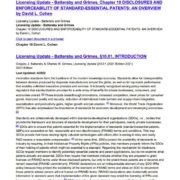DISCLOSURES AND ENFORCEABILITY OF STANDARD-ESSENTIAL PATENTS (Part 1 of 7)
 I am very pleased to present the 2022 updates to my article on disclosures and enforceability of SEPs in 7 parts. The latest version will be available as soon as the 2022 version of the Licensing Update goes to print (which should be quite soon), but last year’s version can be found here. The text of the numbered footnotes is contained in part 7 of 7.
I am very pleased to present the 2022 updates to my article on disclosures and enforceability of SEPs in 7 parts. The latest version will be available as soon as the 2022 version of the Licensing Update goes to print (which should be quite soon), but last year’s version can be found here. The text of the numbered footnotes is contained in part 7 of 7.
INTRODUCTION
Innovative standards form the backbone of the modern knowledge economy. Standards allow for interoperability between devices produced by disparate manufacturers around the globe, as well as for top-notch performance that enables myriad innovative products and services.[1] It is broadly recognized among policy-makers and regulators that standardization provides for a wide array of benefits for private businesses, consumers, and economies overall.1 Those include breakthrough innovations, increased competition, lower prices for consumer goods, improved quality and security, reduction of international trade barriers and supply-chain integration, specialization and productivity gains, higher growth and job creation.2 Moreover, the World Trade Organization (WTO) has also emphasized the importance of standards for economic development and developing economies.3
Standards are collaboratively developed within standards-development organizations (SDOs), i.e., bodies that provide the framework and structure of standards development for their participants, mainly private businesses.4 SDOs aim at attracting highly valuable technologies by providing the opportunity for technology contributors, who invested in risky and costly R&D, to obtain a return on investment by making their patents essential for the implementation of standards (standard-essential patents, SEPs) accessible on fair, reasonable and non-discriminatory (FRAND) terms and conditions, and thus earning a reasonable royalties for their use.5 To further protect the availability of standards to industry, SDOs also require, in their Intellectual Property Rights (IPRs) policies, that members properly inform the SDOs of their holding of essential patents. Regarding the mechanism for such a disclosure, SDOs encourage members to identify relevant and potentially essential patents and patent applications, without the SDOs themselves conducting any essentiality assessment. SDOs then require that members indicate whether they are prepared to grant licenses on FRAND terms under those disclosed patents and patent applications, but only to the extent they are or become and remain essential to the standard (FRAND commitment). FRAND declarations are an indispensable element of any SDO IPRs policy because they protect the availability of the standard on FRAND terms and allow an SDO to circumvent those patents whose owners will not license on FRAND terms. FRAND declarations also incidentally provide information to standard users that implementation of the given standard may entail the licensing of IPRs and, hence, a reasonable royalty compensation.6 SDOs have so far not adopted a common definition of essentiality. However, essentiality is generally defined in SDO IPRs policies as either “technical essentiality,” that is, the relevant standard cannot, as a technical matter, be implemented without infringing the SEP; or “commercial essentiality,” i.e., the SEP in question is not technically essential in a narrow sense, but the commercial benefits of its implementation (e.g., cost savings, performance improvement, security and reliability) are so important that implementers will typically require access to the SEP.7 Moreover, identification of potentially essential patents may involve specific patent rights, or might be broad notifications that the declarer may possess SEPs without identifying particular rights (“general or blanket declarations”).8
The issue of disclosures of essential patents and identification of potentially essential patents, although largely a technical issue arcane to most external observers, has arisen prominent over the past decade among policy-makers worldwide. Regulators have raised a concern over the failure to properly disclose SEPs and make corresponding FRAND declarations, which might enable SEP-owners to “capture” the standard and impose onerous licensing terms on users once the standard is implemented. Moreover, alleged deficiencies in disclosures have been raised as a defense in SEP-infringement actions in the EU and the United States. In the United States, defendants have alleged that failure on the part of the SEP owner to disclose—or failure to disclose in a timely manner—its SEP amounts to an antitrust offence (“patent ambush”), or that it constitutes an “implied waiver” precluding the enforcement of the SEP in question. The present article attempts a critical overview of the responses by regulators and courts when confronted with issues around disclosures of essential patents and attempts to put policy and litigation developments into a broader perspective.





